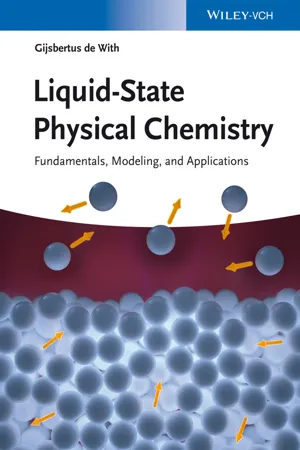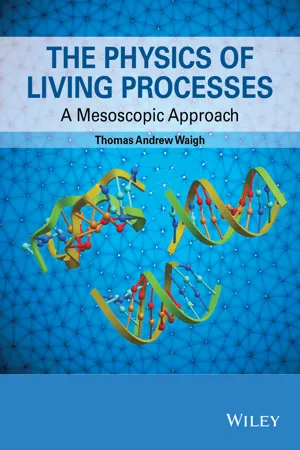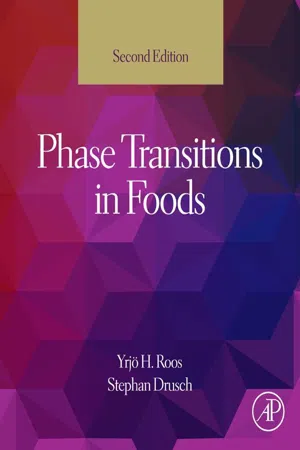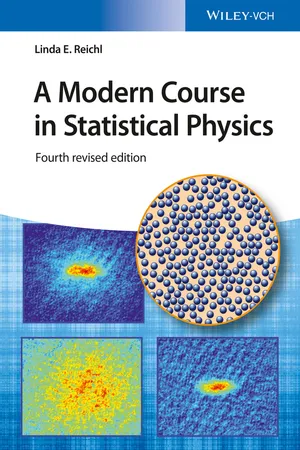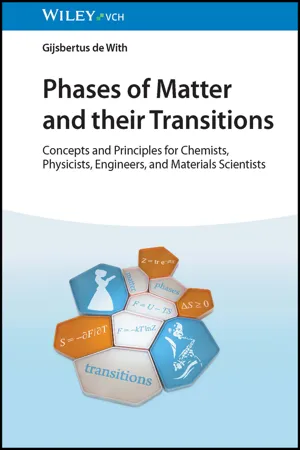Technology & Engineering
Continuous Phase Transition
A continuous phase transition is a type of phase transition in physics where a material undergoes a smooth change in its properties, such as density or magnetization, as it crosses a critical point. Unlike a discontinuous phase transition, there is no abrupt change in the material's properties at the critical point. This type of transition is characterized by the emergence of long-range correlations and critical phenomena.
Written by Perlego with AI-assistance
Related key terms
Related key terms
1 of 4
Related key terms
1 of 3
5 Key excerpts on "Continuous Phase Transition"
- eBook - ePub
Liquid-State Physical Chemistry
Fundamentals, Modeling, and Applications
- Gijsbertus de With(Author)
- 2013(Publication Date)
- Wiley-VCH(Publisher)
16 Some Special Topics: Phase TransitionsIn Chapter 2 we reviewed general thermodynamics but avoided phase transitions. In this chapter, we discuss some aspects of these phenomena, dealing first with some general aspects and thereafter with discontinuous and continuous transitions, in particular the latter providing a rich part of physical chemistry.16.1 Some General Considerations
By changing the conditions – such as P or T – for many materials, a transition from one phase to another can be induced. Under certain conditions even two phases of the same material may coexist. As each of the two phases has its own Gibbs energy expression, under these conditions the chemical potentials of the phases are equal. The Gibbs energy G itself is always continuous over the transition, but the partial derivatives ∂G/∂T and ∂G/∂P may be discontinuous (Figure 16.1 ). In that case, the phase transformation is denoted discontinuous1) (or first-order), while for the situation where the first derivative is continuous, but the higher derivatives are either zero or infinite, one speaks of a continuous (or second-order) phase transition.Figure 16.1Schematic of the behavior of the Gibbs energy G for two phases around (a) Continuous Phase Transition and (b) discontinuous phase transformation. In both cases the stable states below the transition temperature have a Gibbs energy G1 , while above the transition temperature the Gibbs energy is G2 . The continuous transition occurs at the critical temperature Tcri with a continuous change in G, that is, ∂ΔG/∂T = 0, where ΔG = G2 − G1 . The dotted line indicates the metastable continuation of the high temperature G below Tcri . The discontinuous transition occurs at a certain transition temperature Ttra with a discontinuous change in G (∂ΔG/∂T - eBook - ePub
The Physics of Living Processes
A Mesoscopic Approach
- Thomas Andrew Waigh(Author)
- 2014(Publication Date)
- Wiley(Publisher)
phase diagrams are required to describe the relative amounts of the coexisting phases. The standard everyday states of matter are the crystalline (a regular incompressible lattice), the liquid (an irregular incompressible lattice) and the gas (an irregular compressible lattice) phases. However, there are also other less conventional phases such as amorphous solids, rubbers and glasses that occur in Nature and our intuition concerning their mechanical behaviour and microstructure needs careful consideration. Liquid crystals and gels also commonly occur in biology and present additional possibilities for the thermodynamic state of a material. Other more exotic examples of phase changes studied in this book include wetting (e.g. water drops on lotus leaves), and complexation (e.g. DNA compaction in chromosomes); the range of possible thermodynamic phases of a biological molecule is vast.Some of the basic phenomena that concern phase transitions will be recapped before they are applied to a range of biophysical problems. Hopefully readers will have encountered many of these concepts previously in an introductory thermodynamics course. The two states between which a first-order phase transition occurs are distinct, and occur at separate regions of the thermodynamic configuration space. First-order phase transformations experience a discontinuous change in all the dependent thermodynamic variables, except the free energy, during the phase transition. In contrast, the states between which a second-order phase transition occurs are contiguous states in the thermodynamic configuration space. In these Continuous Phase Transitions (2nd , 3rd , 4th , etc.), the dependent variables such as the heat capacity, compressibility and surface tension, diverge or vanish as the independent variables approach a critical value, e.g. a critical temperature (Tc ). This divergence occurs in a characteristic manner around the critical point, for example if the heat capacity (Cv , the ability of the material to store thermal energy) diverges as a function of the temperature near to the critical temperature for a phase transition (Tc ) its functional form is Cv ~ (T–Tc )–α . The exponents α are found to be universal, dependent on the class and symmetry of the Continuous Phase Transition, but not on the exact details of the material’s molecular components.The differences between a first- and a second-order phase transition, can be illustrated by the consideration of the heat capacity (Cp ) and the enthalpy (H) as a function of temperature (Figure 5.1 - eBook - ePub
- Yrjo H Roos, Stephan Drusch(Authors)
- 2015(Publication Date)
- Academic Press(Publisher)
Chapter 1Introduction to phase transitions
Abstract
Phase transitions are changes in the physical state of materials. Thermodynamic properties of materials are required for the analysis of phase and state transitions. Gibbs energy is a useful parameter for the understanding of equilibrium and nonequilibrium states in foods. Classification of phase transitions may follow that of Ehrenfest. First-order transitions show discontinuity in heat capacity while second-order transitions have a step-change in heat capacity at the transition temperature. Raoult’s law provides an important relationship for composition dependence of equilibrium properties of food materials.Keywords
Thermodynamics; Gibbs energy; Phase Transitions; First order transitions; second order transitions; Raoults law; phase diagrams1.1 Introduction
Phase transitions are changes in the physical state of materials, which have significant effects on their physical properties. Chemically pure compounds such as water or many organic and inorganic compounds in foods have exact phase transition temperatures. There are three basic physical states, which are the solid, the liquid, and the gaseous states. The term transition refers to the change in the physical state that is caused by a change in temperature or pressure. Heating of solid foods is often used to observe temperatures at which changes in thermal or physical properties, for example, in heat capacity, viscosity, or textural characteristics, occur.Water is one of the most important compounds in nature and also in foods. It may exist in all of the three basic states during food processing, storage, and consumption. The effect of water on the phase behavior of food solids is of utmost importance in determining processability, stability, and quality. Well-known examples include transformation of liquid water into ice (freezing) or water into vapor (evaporation). These transitions in phase are the main physical phenomena that govern food preservation by freezing and dehydration. Engineering and sensory characteristics of food materials are often defined by the complicated combination of the physical state of component compounds. The main constituents of food solids are carbohydrates, proteins, water, and fat. These materials may exist in the liquid state and the solid crystalline or amorphous noncrystalline state. Many of the component compounds, for example, sugars, fats, and water, when they are chemically pure, crystallize below their equilibrium melting temperature. - eBook - ePub
- Linda E. Reichl(Author)
- 2016(Publication Date)
- Wiley-VCH(Publisher)
4 The Thermodynamics of Phase Transitions4.1 Introduction
A thermodynamic system can exist in a number of different phases and the macroscopic behavior of these various phases can differ dramatically. Generally, systems become more ordered as temperature is lowered because forces of cohesion begin to overcome thermal motion and atoms can rearrange themselves into more ordered states. Phase changes occur abruptly at some critical temperature, although evidence that a phase change will occur can be found on a macroscopic scale as the critical temperature is approached. In this chapter we will be concerned with the thermodynamics of phase transitions – that is, the description of phase transitions in terms of macroscopic variables. In later chapters we shall study them from a microscopic point of view.The first step in analyzing phase changes is to map out the phase diagram for the system. At a transition point, two (or more) phases can coexist in equilibrium with each other. Since phases can exchange thermal and mechanical energy and matter, equilibrium occurs when the chemical potentials of the phases become equal for given values of Y and T. From this equilibrium condition, we can determine the maximum number of phases that can coexist and, in principle, find an equation for the regions of coexistence (the Clausius–Clapeyron equation, for example).Phase transitions can be divided into two classes according the behavior of the Gibbs free energy. Phase transitions with discontinuous first derivatives of the Gibbs free energy (taken with respect to T and Y) are called first-order phase transitions. Phase transitions with continuous first derivatives, but discontinuous higher order derivatives, are called Continuous Phase Transitions. We give examples of both in this chapter.Classical fluids provide some of the most familiar examples of first-order phase transitions. The vapor–liquid, vapor–solid, and liquid–solid transitions are all first order. For these phase transitions, we can use the Clausius–Clapeyron equation to find explicit approximate equations for the coexistence curves. Since the vapor–liquid transition terminates in a critical point, we will focus on this transition and compare the observed behavior of the vapor–liquid coexistence region to that predicted by the van der Waals equation. - eBook - ePub
Phases of Matter and their Transitions
Concepts and Principles for Chemists, Physicists, Engineers, and Materials Scientists
- Gijsbertus de With(Author)
- 2023(Publication Date)
- Wiley-VCH(Publisher)
15 Continuous Phase Transitions: Liquids ↔ GasesIn Chapters 13 and 14 , we discussed disContinuous Phase Transitions. In this chapter, we discuss aspects of Continuous Phase Transitions, mainly focusing on the liquid–gas transition. Continuous Phase Transitions provide a particularly rich part of chemical physics and considerable effort has been paid to describe and understand them. This has led to an image that captures the essentials well. In the sequel, we first discuss some experimental facts, thereafter mean‐field theory, scaling, and renormalization.15.1 Limiting Behavior
We recall that thermodynamic equilibrium is determined by minimization of the appropriate potential with respect to the (relevant) internal variable(s). For the liquid–gas transition, the density difference Δρ = ρ − ρcri is single valued above Tcri , has two values below Tcri , and Δρ is conventionally used as the internal variable. In connection with transitions, the internal variable used is often called the order parameter. For liquids, both single‐compound liquids and liquid mixtures exhibit continuous transitions. As an example, in Figure 15.1 the reduced density (ρL − ρV )/2ρcri of CO2 versus the reduced temperature t ≡ (T − Tcri )/Tcri is given, while Figure 15.2 shows the difference in volume fraction φ(1) − φ(2) for CCl4 in C7 F14 versus t. In both cases, the behavior close to Tcri is described by a power law [1 , 2 ].This type of experiment has led to the definition of various critical exponents. A critical exponent of a function, say a for a function f(x) of x, is defined byand we write f(x) ∼ xa. This does not imply that f(x) = Axabut rather that f(x) = Axa(1 + Bxb+ …) with b > 0, and where Axais called the singular part of f(x) and 1 + Bxb+ … the regular part or background function. The exponent a defines the rate of approach of f(x) to zero for a > 0 or to infinity for a < 0. If a = 0, the result is ambiguous. In this case, f(x) shows either a discontinuity or else has a logarithmic singularity, that is, f(x) behaves like ln(T − Tcri
Index pages curate the most relevant extracts from our library of academic textbooks. They’ve been created using an in-house natural language model (NLM), each adding context and meaning to key research topics.
Explore more topic indexes
Explore more topic indexes
1 of 6
Explore more topic indexes
1 of 4
